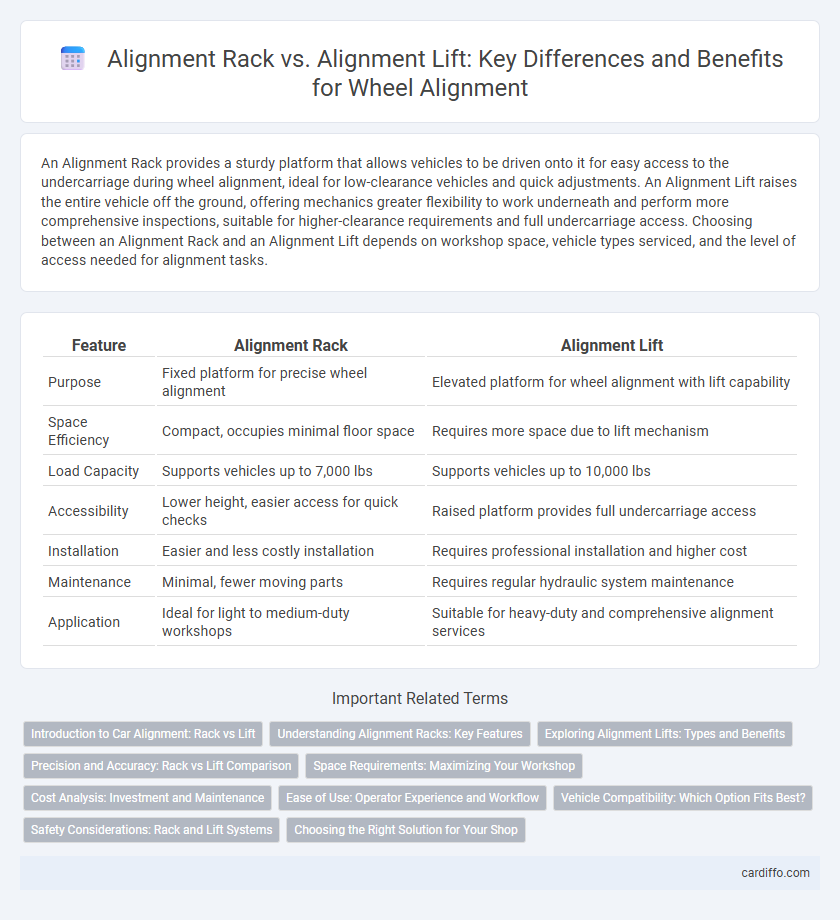An Alignment Rack provides a sturdy platform that allows vehicles to be driven onto it for easy access to the undercarriage during wheel alignment, ideal for low-clearance vehicles and quick adjustments. An Alignment Lift raises the entire vehicle off the ground, offering mechanics greater flexibility to work underneath and perform more comprehensive inspections, suitable for higher-clearance requirements and full undercarriage access. Choosing between an Alignment Rack and an Alignment Lift depends on workshop space, vehicle types serviced, and the level of access needed for alignment tasks.
Table of Comparison
| Feature | Alignment Rack | Alignment Lift |
|---|---|---|
| Purpose | Fixed platform for precise wheel alignment | Elevated platform for wheel alignment with lift capability |
| Space Efficiency | Compact, occupies minimal floor space | Requires more space due to lift mechanism |
| Load Capacity | Supports vehicles up to 7,000 lbs | Supports vehicles up to 10,000 lbs |
| Accessibility | Lower height, easier access for quick checks | Raised platform provides full undercarriage access |
| Installation | Easier and less costly installation | Requires professional installation and higher cost |
| Maintenance | Minimal, fewer moving parts | Requires regular hydraulic system maintenance |
| Application | Ideal for light to medium-duty workshops | Suitable for heavy-duty and comprehensive alignment services |
Introduction to Car Alignment: Rack vs Lift
Car alignment ensures optimal tire contact and vehicle stability by accurately adjusting suspension angles. An alignment rack provides a stable, low-profile platform specifically designed for precise wheel positioning, while an alignment lift elevates the vehicle for comprehensive undercarriage access during adjustments. Choosing between a rack and a lift depends on workshop space, vehicle types, and the level of access required for alignment procedures.
Understanding Alignment Racks: Key Features
Alignment racks feature a sturdy platform with integrated turn plates and slip plates designed for precise wheel positioning, enabling accurate vehicle adjustments. These racks prioritize ease of access and stability, allowing technicians to perform wheel alignments efficiently without vehicle movement during service. Compared to alignment lifts, alignment racks often provide enhanced measurement accuracy due to their fixed, level setup and specialized alignment hardware.
Exploring Alignment Lifts: Types and Benefits
Alignment lifts offer versatile solutions for vehicle maintenance, including two-post, four-post, and scissor lifts, each designed to accommodate different workshop needs and vehicle types. These lifts enhance efficiency and safety by providing stable access to the vehicle's underside, facilitating precise wheel alignment and suspension adjustments. Investing in the right alignment lift improves workflow, reduces labor time, and ultimately leads to more accurate alignment results and extended tire life.
Precision and Accuracy: Rack vs Lift Comparison
Alignment racks provide superior precision by offering a stable, fixed platform that ensures consistent measurements and adjustments during vehicle alignment. Alignment lifts, while versatile and space-saving, may introduce slight variances due to their movable and elevated structure, affecting overall accuracy. Technicians often prefer racks for high-precision tasks where exact alignment tolerances are critical for optimal vehicle handling and tire wear.
Space Requirements: Maximizing Your Workshop
Alignment racks require less vertical clearance compared to alignment lifts, making them ideal for workshops with low ceilings and limited overhead space. Alignment lifts occupy more floor space but offer greater accessibility for under-vehicle inspections and repairs. Choosing between the two depends on prioritizing compact space usage or enhanced vehicle access within your workshop layout.
Cost Analysis: Investment and Maintenance
Alignment racks generally require a lower initial investment compared to alignment lifts, making them a more cost-effective choice for small to mid-sized automotive shops. Maintenance expenses for alignment racks tend to be minimal due to their simpler mechanical components and fewer hydraulic parts. Alignment lifts, while offering enhanced versatility and space efficiency, involve higher upfront costs and more frequent maintenance due to complex hydraulic systems, impacting long-term operational budgets.
Ease of Use: Operator Experience and Workflow
Alignment racks offer a streamlined operator experience with straightforward positioning and minimal adjustments, enhancing workflow efficiency in busy automotive shops. Alignment lifts provide elevated access, reducing physical strain and improving visibility for technicians, which can accelerate complex alignment tasks. Both systems optimize ease of use but cater to different operational preferences, with racks favoring speed and lifts focusing on ergonomic comfort.
Vehicle Compatibility: Which Option Fits Best?
Alignment racks offer superior vehicle compatibility, accommodating a wide range of vehicle sizes and wheelbases typically found in passenger cars and light trucks. In contrast, alignment lifts provide enhanced accessibility for heavier and larger vehicles like SUVs and commercial trucks, enabling technicians to perform adjustments more efficiently. Selecting between an alignment rack and an alignment lift depends largely on the shop's primary vehicle types and service requirements.
Safety Considerations: Rack and Lift Systems
Alignment racks offer increased safety through their sturdy, low-profile design that minimizes vehicle movement and risk of tipping during alignment procedures. Alignment lifts provide enhanced accessibility and versatility, allowing technicians to safely elevate vehicles for comprehensive inspections and adjustments while incorporating advanced locking mechanisms to prevent accidental drops. Both systems require adherence to manufacturer safety protocols and regular maintenance to ensure optimal performance and technician safety.
Choosing the Right Solution for Your Shop
Choosing between an alignment rack and an alignment lift depends on your shop's space, vehicle types, and budget. Alignment racks offer precise measurements and are ideal for high-volume tire and wheel shops, while alignment lifts provide versatility for multiple service tasks beyond alignment. Prioritize your shop's workflow efficiency and customer needs to select the solution that maximizes productivity and return on investment.
Alignment Rack vs Alignment Lift Infographic

 cardiffo.com
cardiffo.com